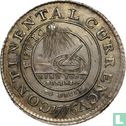

Enlarge image


Catalogue information
LastDodo number
4711135
Area
Coins
Title
United States 1 dollar 1776 (silver)
Country
Face value
Year
1776
Variety / overstrike
zilver
Head of State
Type
Designer
Series
Theme
Material
Gold- or silver content
Weight
Diameter
41
Thickness
Punch
Shape
Obverse
CONTINENTAL CURRENCY FUGIO MIND YOUR BUSINESS EG FECIT 1776
Reverse
N. HAMP,s MASSASCHs CONNECT. T R. ISLAND N. YORK N. JERSEY PENNSILV DELAWARE MARYLAND VIRGINIA N. CAROLIN S. CAROLIN GEORGIA AMERICAN CONGRESS WE ARE ONE
Edge
Reeded
Privy mark
Mint mark
Number produced
Krause and Mishler number
KM# EA2a
Catalogue number
Details
The Continental Currency dollars were struck primarily in pewter, but a few examples are known in brass and silver. Newman identified five obverse and four reverse dies, which were combined to produce seven different die varieties for the series, ranging from Newman 1-A to 5-D. On obverse 1, the word currency is spelled CURENCY; on obverse 2, it is properly spelled CURRENCY; on obverse 3, the spelling is as on obverse 2, with the addition of EG FECIT (appearing only on this obverse); on obverse 4, the spelling is altered to CURRENCEY; and on obverse 5, the spelling is corrected to CURRENCY by punching a Y over the excess E, and adding a floriated cross to cover the extra Y. The reverses are as follows: reverse A shows the linked chain made up of dotted lines; on reverse B, the dots are partially cut into lines; the rings have been completely reworked as lines on reverse C; and reverse D has the same linked chain, but the names of the states appearing within have been reordered geographically, with N.HAMPS now to the left of MASSACHS.
Eric P. Newman, Don Taxay, Walter Breen, Philip Mossman, and Michael Hodder spent many years researching the Continental Currency coinage, mesmerized by its mysterious origins. No authorization for the production of the Continental Currency coinage has come to light, but it is probable that the coins were intended to take the place of the dollar-denominated paper currency issued by the Continental Congress in the latter part of 1776. The four resolutions from May 10, 1775 to May 9, 1776 provided for the issue of paper money in various denominations, including the one dollar bill. The six resolutions of July 22, 1776 through September 26, 1778 omitted the one dollar denomination. Thus, it is logical to conclude the pewter pieces were intended as a substitute for the paper dollars in those issues. The coins had minimal intrinsic value, and like the paper bills they replaced, were valued according to the public's confidence in Congress, who guaranteed their value at one dollar each.
The mintage figures are unknown, but the pewter coins appear with enough frequency to suggest they were produced in substantial numbers. Many of the coins were undoubtedly melted during this period, because Benjamin Franklin observed that pewter was sorely needed for the canteens used by soldiers in the Continental Army. The most reasonable explanation for the brass examples is that they represent dies trials. The silver coins are of full weight and value, suggesting that a precious-metal coinage was contemplated, but the Continental Congress was chronically short of funds and had no reliable supply of silver, so this idea must have been abandoned quickly.
Newman's obverse die number 3 features the EG FECIT (Latin for EG made it) lettering on the obverse. This die is one of the very few signature dies from the colonial period, as Michael Hodder reports the only other examples are the Chalmers coins signed TS for Thomas Sparrow and the unique New Jersey copper signed WM for Walter Mould; further research has shown that the obverse of Maris-62 also contains the letters WM, hidden under the left and right leaves below the horse's head. Eric P. Newman identified Elisha Gallaudet as the engraver of the dies in his article The Continental Dollar of 1776 Meets its Maker, reproduced in this catalog. Gallaudet also engraved the plates for printing the City of New York waterworks notes and the February 17, 1776 Continental Currency one-sixth dollar notes. A comparison of the design and craftsmanship of the latter notes and the Continental Currency dollar coin dies suggests they were all engraved by the same person, Elisha Gallaudet.
Although there was no organized numismatic community in the United States until about 1855, coin collecting was well-established in Europe in the late 18th century. European collectors began collecting and studying the Continental Currency dollars at an early date, and a printed illustration of the coin was published in Allgemeines historisches Taschenbuch, by Matthias Christian Sprengel in Berlin in 1784. Bishop Richard Watson analyzed a pewter example of the Continental Currency dollar in his 1786 scientific study titled Chemical Essays, Vol. 4. Some of the finest Continental Currency dollars we know about today, including the present coin, were preserved by European numismatists for many years before being repatriated to this country, after the hobby gained sufficient popularity to make them sought-after and valuable items.
The different varieties in pewter have been avidly collected since the earliest days of the hobby in this country; the brass and silver coins have always been extremely rare. Sylvester Sage Crosby was aware of pewter examples of the Newman 3-D variety, but the silver coins were discovered only after he wrote The Early Coins of America in 1875. Today, we know of two examples, including the present coin. Crosby recorded a silver example of the Newman 1-C (Parmelee Collection) and a Newman 1-B in brass (Brevoort Collection). Current census data shows the following examples: Newman 1-C, two in silver; Newman 1-A, two in brass; and Newman 1-B in brass, six to eight.



